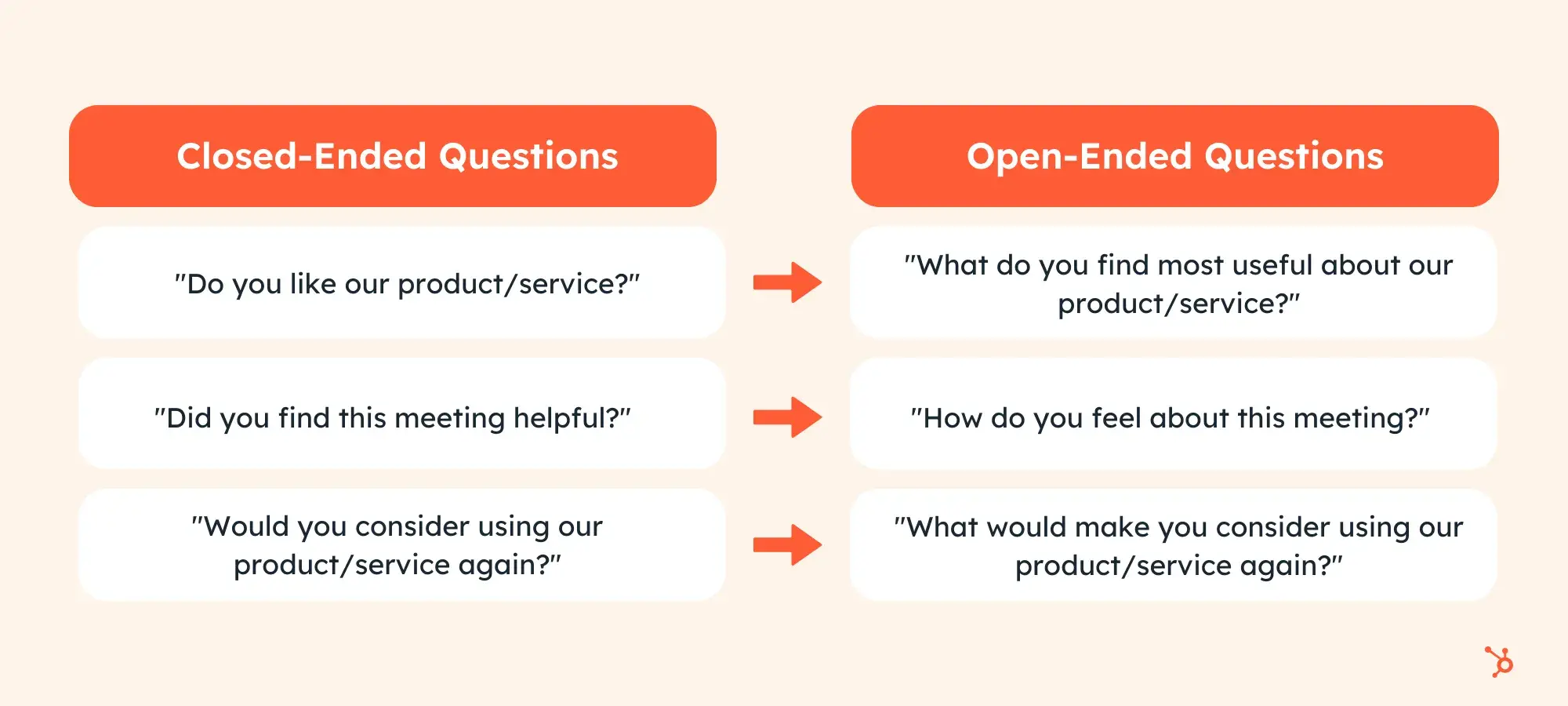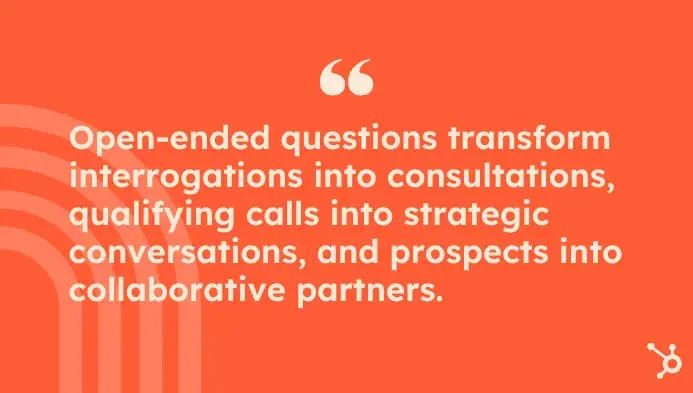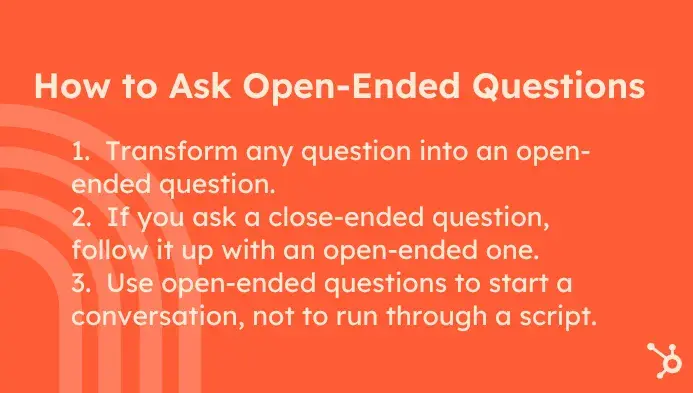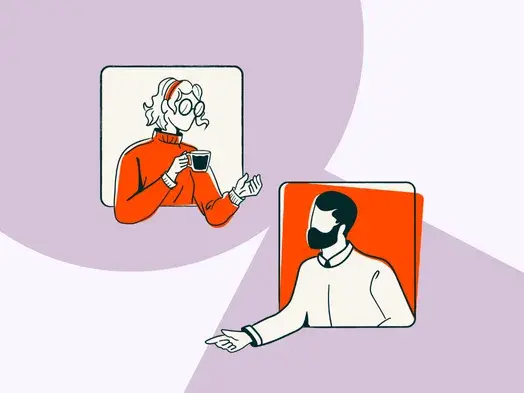I was asking questions, sure. But they were the wrong questions: close-ended, checklist-driven inquiries that gathered data without building understanding. I was interrogating, not investigating. I was qualifying, not connecting.
That call ended with a polite “we'll be in touch” that never came. But it taught me something that changed how I approach every sales conversation: The quality of your questions determines the quality of your relationships.
And the quality of your relationships determines the quality of your deals.
Here‘s what I’ve learned about the art of asking open-ended questions and how to use them to build deeper relationships, uncover real needs, and close more deals.
Table of Contents
- What are open-ended questions?
- Open-Ended vs. Closed-Ended Questions
- How to Ask Open-Ended Questions
- Examples of Open-Ended Questions
What are open-ended questions?
An open-ended question is any question that can't be answered with a simple yes, no, or one-word response. These questions invite exploration, encourage storytelling, and create space for prospects to share what's really on their mind.
But here‘s what most sales training gets wrong: open-ended questions aren’t just about gathering information. They're about creating experiences.
Since that disastrous call I mentioned with the CFO, I‘ve refined my questioning approach across 11,519 cold calls, 335 booked meetings, and over $406K in closed revenue. I’ve sold to CFOs in São Paulo, CTOs in Dubai, and founders in Silicon Valley.
And through all of that experience, I‘ve learned that open-ended questions aren’t just a sales technique — they're the foundation of trust, the catalyst for insight, and the bridge between what prospects tell you and what they actually need.
Research backs this up: According to recent studies, sales reps who consistently close deals listen more than they talk, maintaining a 60/40 split in favor of listening.
The best way to create space for listening? Asking questions that can't be answered with a simple yes or no.
When I ask a prospect, “What keeps you up at night about your current sales process?” I‘m not just looking for problems to solve. I’m inviting them to reflect on their challenges, articulate their frustrations, and begin to envision what a solution might look like.
That question creates a shared moment of exploration that builds trust and rapport.
I learned the power of this approach when working with a fintech startup. Instead of asking typical qualifying questions like “Do you have budget?” I shifted to “How do you typically approach investments in technology that could impact your growth trajectory?” That single question change transformed a 15-minute qualifying call into a 45-minute strategic conversation that led to a six-figure deal.
The best open-ended questions do three things simultaneously:
- Gather insight about the prospect's situation.
- Encourage reflection that helps prospects think differently about their challenges.
- Build a connection between you and the person you're speaking with.
The key is understanding that open-ended questions don't just extract information: they transform conversations. And in sales, the quality of your conversations directly determines the quality of your outcomes.
Open-Ended vs. Closed-Ended Questions
Let me show you the difference with a real example from my own experience selling to a VP of Sales at a growing SaaS company.
My old closed-ended approach:
- “Do you have a sales process?”
- “Are you hitting your revenue targets?”
- “Is sales enablement a priority?”
- “Would you like to see a demo?”
My refined open-ended approach:
- “How would you describe your current sales process?”
- “What's happening with your revenue growth right now?”
- “Where does sales enablement fit into your strategic priorities?”
- “What would you need to see to feel confident about moving forward?”
See the difference? The closed-ended questions gave me data points. The open-ended questions gave me understanding.

I learned this distinction the hard way when I was working with a startup that was struggling to close enterprise deals. Their reps were asking plenty of questions, but they were all closed-ended. They'd qualify budget, authority, need, and timeline (classic BANT methodology), but they never understood the human context behind those answers.
When we shifted to open-ended questions, everything changed.
Instead of asking “Do you have budget for this?” we started asking, “How do you typically approach budget allocation for strategic initiatives like this?” Instead of “Are you the decision-maker?” we asked, “Who else would be involved in evaluating and implementing a solution like this?”
The conversations became richer. The insights became deeper. And the close rate jumped from 18% to 31% in six weeks.
When to Use Open-Ended vs. Closed-Ended Questions
Closed-ended questions work best for:
- Confirming specific facts (“What's your company size?”).
- Getting quick yes/no decisions (“Does Thursday at 2 PM work for you?”).
- Validating assumptions (“Are you currently using Salesforce?”).
- Moving toward commitment (“Are you ready to move forward?”).
Open-ended questions excel at:
- Understanding context and nuance.
- Building rapport and trust.
- Uncovering pain points and motivations.
- Encouraging prospects to share their story.
- Creating moments of reflection.
According to recent research, the most effective sales conversations maintain a 43:57 talk-to-listen ratio, meaning top performers listen more than they speak. Open-ended questions are the key to creating that listening space.

Both question types have their place in sales conversations. But if you want to differentiate yourself in a world where buyers are skeptical of salespeople, open-ended questions are your secret weapon. They transform interrogations into consultations, qualifying calls into strategic conversations, and prospects into collaborative partners in the problem-solving process.
The magic happens when you use them intentionally, not as checklist items, but as tools for genuine exploration and connection.
How to Ask Open-Ended Questions
After thousands of sales conversations, I‘ve developed a systematic approach to asking open-ended questions that feels natural, not scripted. The key isn’t memorizing a list of questions, but mastering the art of transforming any interaction into genuine exploration.
I learned this lesson when struggling to connect with a particularly analytical CFO. Every closed-ended question I asked got one-word responses. But when I shifted to “How do you currently measure the success of technology investments?” suddenly we were having a 20-minute conversation about ROI frameworks and strategic priorities.
The magic words are “how,” “what,” and “why.”
They turn statements into stories, facts into feelings, and answers into insights. Instead of asking “Do you like your current vendor?” I ask, “How has your experience been with your current vendor?” The difference is transformational.
But here's where most reps go wrong: they treat open-ended questions like items on a checklist rather than tools for genuine exploration. I start with one or two powerful questions and let the conversation evolve naturally. If a prospect mentions something interesting, I dig deeper rather than moving to the next item on my list.
This approach is backed by research from Gong, which found that top-performing sales reps ask 54% more questions than average performers, but the quality of those questions matters more than the quantity.
The goal isn‘t to ask more questions, it’s to ask better ones that create space for real dialogue and genuine understanding.

Transform any question into an open-ended question.
This is the skill that transformed my entire approach to sales conversations. I teach every rep I coach to master this simple but powerful technique: Take any closed-ended question and turn it into an open-ended exploration.
The transformation is easier than you think. Here are the patterns I use daily:
|
Closed-ended question |
open-ended question |
|
Instead of: “Do you like your current vendor?” |
Ask: “How has your experience been with your current vendor?” |
|
Instead of: “Is price important to you?” |
Ask: “How do you typically evaluate the ROI on investments like this?” |
|
Instead of: “Are you ready to move forward?” |
Ask: “What would need to happen for you to feel confident about moving forward?” |
Here's my challenge to you: For the next week, catch yourself every time you ask a closed-ended question. Pause and ask: “Could I rephrase this to learn more?” You'll be amazed how this simple shift changes the quality of your conversations and the depth of insights you uncover.
If you ask a closed-ended question, follow it up with an open-ended one.
Sometimes you need specific information, and a closed-ended question is the fastest way to get it. That‘s perfectly fine, just don’t stop there. Follow up with an open-ended exploration that reveals the context behind the facts.
I've learned to use what I call the “one-two punch” approach: Get the fact, then explore the context.
Here's how this works in real conversations:
Example sequence:
- “Do you have budget allocated for this project?” (closed)
- “How does the budget approval process typically work in your organization?” (open)
Another example:
- “Are you evaluating other solutions?” (closed)
- “What's your process for evaluating different options, and what criteria matter most to you?” (open)
I discovered this technique during a call with a procurement director who was giving me very short answers. When I asked, “Do you like working with your current vendor?” she said simply, “Not really.” Instead of moving on, I followed up with, “What would an ideal vendor relationship look like for you?” That follow-up question opened up a 15-minute conversation about their frustrations and exactly what they needed to change.
You see the pattern? The closed-ended question gives you the basic facts you need for qualification, but the follow-up open-ended question reveals the context that helps you tailor your approach and build rapport.
This approach is particularly powerful when confirming next steps. Instead of just asking, “Does next Tuesday work for a follow-up?” I might say, “Does next Tuesday work for a follow-up? And what would you like to accomplish in that conversation?”
The key is training yourself to pause after any closed-ended question and ask: “What's the story behind that answer?” That's usually where the real insights (and the real opportunities!) are hiding.
Use open-ended questions to start a conversation, not to run through a script.
Here's where most reps go wrong: they treat open-ended questions like items on a checklist rather than tools for genuine exploration.
I once shadowed a rep who had memorized a list of 20 open-ended questions and was determined to ask every single one, regardless of how the conversation flowed. When a prospect mentioned they were struggling with team morale after a recent layoff, instead of exploring that comment, he moved straight to his next scripted question about budget. The prospect visibly shut down.
That's when I realized the fundamental difference between questioning and conversing. Open-ended questions should spark natural dialogue, not create robotic interrogations.
I approach discovery calls differently now. I start with one powerful open-ended question and let the conversation evolve organically. When a prospect says, “We're struggling with sales productivity,” I don't immediately jump to my next prepared question. I explore: “What does that struggle look like day-to-day for your team?” Then I might follow naturally with: “How long has this been an issue?” or “What have you tried to address it so far?”
The key is listening to the answers and using them as springboards for deeper exploration. If someone mentions a challenge with their current vendor, I dig into that. If they talk about a strategic initiative, I explore the context and implications. The conversation should feel like a collaborative investigation, not a deposition.
This approach requires comfort with uncertainty. You can‘t control where open-ended questions will lead, and that’s exactly the point. The tangents and unexpected directions often reveal the most valuable insights.
I always remind myself: I‘m not here to execute a script. I’m here to understand a human being and their business challenges. Open-ended questions are simply the vehicle for that understanding.
Examples of Open-Ended Questions
- What are the top priorities of your business at the moment?
- What are some of the best decisions you’ve made related to ___?
- How are you feeling about your current situation related to ___?
- If we met five years from today, what needs to happen for you to feel good about your business situation related to ___?
- What opportunities do you see on your horizon?
- What challenges do you see to making those opportunities happen?
- How will you be measuring your success related to those outcomes?
- What’s the biggest risk of your not making progress on this situation?
- Who needs to be involved in making the final purchasing decision?
- What is the motivation behind taking on this project?
Below, I’ll dig into these open-ended, high-value questions and share why they worked for me.
1. What are the top priorities of your business at the moment?
This question has opened more doors for me than any other single question in my sales toolkit. It's deceptively simple, but incredibly powerful because it invites prospects to share their strategic thinking rather than just their tactical challenges.
I learned the power of this question during a call with a fast-growing fintech CEO. Instead of asking “What problems are you trying to solve?” I asked about their top priorities. What followed was a 20-minute conversation about their expansion into new markets, regulatory compliance concerns, and the need to scale their operations team. That context helped me position our solution not as a nice-to-have tool, but as a strategic enabler for their growth plans.
The beauty of this question is that it reveals the hierarchy of what matters most to them right now. When someone says, “Our top priorities are customer retention, international expansion, and improving our unit economics,” I immediately understand where to focus my energy and how to frame our value proposition.
I‘ve found that prospects appreciate this question because it shows I’m thinking strategically about their business, not just trying to find a problem my product can solve. It also helps me understand whether our solution aligns with their current priorities or if the timing might be wrong.
Follow-up questions that work well here include: “What's driving those priorities?” or “How are you currently addressing each of these areas?” This creates a natural flow into deeper discovery about their specific challenges and initiatives.
2. What are some of the best decisions you’ve made related to ___?
This question is pure gold because it gets prospects talking about their wins while revealing their decision-making criteria and values. I learned its power during a call with a VP of operations who had been giving me short, guarded answers about their current challenges.
When I shifted to asking “What are some of the best decisions you've made related to scaling your operations?” his entire demeanor changed. He lit up talking about how they'd implemented a new workflow automation system that reduced processing time by 40%. As he shared the story, I learned exactly what mattered to him: measurable efficiency gains, minimal disruption to his team, and quick time-to-value.
That insight completely changed how I positioned our solution. Instead of leading with features, I framed our conversation around delivering similar measurable improvements with minimal implementation friction.
This question works because it taps into natural human psychology: People love sharing their successes. But more importantly for sales, it reveals their definition of “good decisions.” When someone tells you about their best choices, they're essentially giving you their buying criteria and success metrics.
I often customize this question based on the context: “What are some of the best technology investments you've made?” or “What are some of the best hiring decisions that have impacted your team?” The specificity helps focus their response while still allowing them to choose what they want to highlight.
The follow-up question I always ask to this one is, “What made those decisions successful?” This uncovers their evaluation process and helps me understand how they define ROI and measure success.
3. How are you feeling about your current situation related to ___?
This question might feel too personal for a business conversation, but that's exactly why it works so well. It breaks through the professional facade and gets to the human reality behind the business challenges.
I discovered the power of this approach during a discovery call with a CTO who was being unusually evasive about their technology challenges. When I asked the standard “What issues are you facing with your current system?” he gave me textbook answers about “scalability concerns” and “integration challenges.” But when I shifted to “How are you feeling about your current technology situation?” the conversation changed.
He paused for a moment, then said, “Honestly? Frustrated. We're spending more time fighting our tools than building solutions for our customers.” That one word, “frustrated,” opened up a 30-minute conversation about the real impact of their technology problems on team morale, customer satisfaction, and his own stress levels.
The word “feeling” is crucial here because it gives people permission to be human rather than just professional. It moves the conversation from facts to emotions, and emotions drive decisions far more than features and benefits ever will.
I often customize this question based on the context: “How are you feeling about your current sales performance?” or “How are you feeling about your team's productivity levels?” The key is to focus on an area where you suspect there might be some emotional weight, such as satisfaction, frustration, confidence, or concern.
This question works because it creates psychological safety. You‘re acknowledging that business challenges aren’t just operational problems; they're human experiences that affect real people. That acknowledgment often leads to the kind of honest, vulnerable conversations where real trust begins to form.
4. If we met five years from today, what needs to happen for you to feel good about your business situation related to ____?
This question is a game-changer because it shifts the conversation from problems to possibilities. I've used variations of this question to unlock some of the most strategic conversations of my sales career.
I remember using this with a founder who had been giving me tactical answers about their current sales challenges. When I asked, “If we're sitting here five years from now and you're feeling great about how your sales organization has evolved, what happened to get you there?” everything changed. Instead of talking about pipeline problems, we started discussing his vision of building a world-class revenue machine that could scale globally.
That future-focused framing helped him articulate aspirations he hadn‘t even fully formed yet. He talked about wanting a sales team that could predictably generate $50M annually, systems that could support international expansion, and a culture where top talent wanted to work. Suddenly, our conversation wasn’t about fixing a problem: it was about building toward a vision.
The beauty of this question is that it removes the pressure of immediate planning while encouraging strategic thinking. People often have clearer pictures of their desired future than they do of their current problems. When you ask them to paint that picture, you get insights into their deepest motivations and long-term priorities.
I often follow this up with, “What would have to change from where you are today to make that vision a reality?” This creates a natural bridge from their ideal future back to present-day action steps, and often positions whatever I'm selling as a critical piece of that transformation.
This question works because it positions you as someone who thinks beyond the transaction to their long-term success. That's the foundation of trusted advisor relationships.
5. What opportunities do you see on your horizon?
This question consistently gets prospects excited because it taps into their growth mindset and entrepreneurial spirit. I've found that talking about opportunities creates energy in conversations in a way that discussing problems never can.
I learned this during a call with a VP of marketing at a scaling SaaS company. We'd been discussing their challenges with lead quality and attribution tracking, a typical problem-focused discovery. The conversation was fine, but not particularly engaging. Then I asked, “What opportunities do you see on your horizon for growth?”
His entire energy shifted. He started talking about expanding into European markets, launching a new product line, and building a partner channel program. As he described these opportunities, I could hear the excitement in his voice. More importantly, I started to see how our marketing automation platform could enable these growth initiatives rather than just solve current problems.
The word “horizon” is key here because it suggests exciting possibilities just within reach, not distant dreams. It frames opportunities as things they can actually capture with the right strategy and tools.
This question often reveals initiatives that aren't widely known yet — expansion plans, new product launches, and strategic partnerships. Getting early insight into these opportunities positions you as a potential growth-enabler rather than just a problem-solver.
I typically follow this up with, “What would need to be in place for you to capitalize on those opportunities?” This creates a natural bridge to discussing how your solution might support their growth objectives.
I love this question because it positions your entire sales conversation around helping them win, not just fixing what‘s broken. That’s a much more compelling value proposition.
6. What challenges do you see to making those opportunities happen?
This is the perfect follow-up to the opportunities question, and it‘s where the real sales magic happens. Instead of asking about generic problems, you’re now exploring the specific obstacles standing between them and their growth goals.
This question works because it maintains the positive momentum from discussing opportunities while naturally transitioning into the challenges where you might be able to help. It frames problems as barriers to success rather than sources of pain, which is a subtle but powerful psychological shift.
I used this sequence with a COO at a logistics company who had just described their opportunity to expand into same-day delivery. When I asked about the challenges to making that happen, he opened up about capacity planning difficulties, real-time tracking limitations, and the need for better route optimization. Those weren't random problems; they were specific obstacles preventing him from achieving something he was excited about.
That context completely changed how I positioned our solution. Instead of selling logistics software to fix problems, I was offering tools to unlock a major growth opportunity. The urgency and motivation were completely different.
The word “challenges” feels more collaborative than “problems” or “roadblocks.” It implies we‘re going to work together to figure out solutions rather than just diagnosing what’s wrong. This subtle language shift keeps the conversation forward-looking and partnership-oriented.
7. How will you be measuring our success related to those outcomes?
This question is brilliant because it accomplishes three things simultaneously: it uncovers their success criteria, creates accountability for results, and positions you as a partner invested in their outcomes rather than just a vendor selling a product.
The word “our” is crucial here because it implies partnership and shared responsibility for results. You‘re not asking what they’ll measure. You're asking how “we” will measure success together. This subtle shift positions you as an ally rather than a vendor.
This question often reveals metrics you wouldn‘t have thought to ask about. Sometimes it’s operational efficiency, sometimes it‘s employee satisfaction, sometimes it’s customer retention. Understanding their specific success criteria allows you to tailor your value proposition and implementation plan accordingly.
This question also sets the foundation for a results-oriented relationship from day one. You're establishing that success will be measured, not assumed.
8. What’s the biggest risk of your not making progress on this situation?
If you were to ask a prospect, “What if you don’t hit your goals?” you could put them in the defensive. Instead, try asking what their risks are of not making progress. Not only is this question less accusatory, but it gives you the chance to work together and strategize on potential risk management practices.
9. Who needs to be involved in making the final purchasing decision?
Finding the right decision maker is critical to making a sale. As you navigate the sales process, make sure you’re working with the right contact.
Let’s be honest, there’s nothing worse than putting in the groundwork to get the deal, only to find out your prospect doesn’t have purchasing authority and can’t sign on the dotted line. Confirming who needs buy-in is a productive, open-ended question.
10. What is the motivation behind taking on this project?
This question helps you understand your prospect’s decision-making process. By learning what your prospect is motivated by, you will get clear on what results they are seeking from your product. This can help you set expectations and speak to the features that matter most to your buyer.
Additionally, by asking your prospect what factors are motivating their buying decisions, you give them a chance to share their values, which is important for building trust.
Conclusion
Looking back on that disaster of a discovery call I mentioned at the beginning, I realize it wasn't just a bad sales technique that cost me that deal. It was a missed opportunity to build a real relationship.
I've since learned that every question you ask is either building trust or eroding it. Every question either creates space for genuine dialogue or reinforces the barrier between you and your prospect. And every question either positions you as a consultant or marks you as just another salesperson going through the motions.
The ten open-ended questions I‘ve shared here aren’t meant to be a script. They‘re tools for genuine curiosity. Use them as starting points, not endpoints. Customize them for your industry, your prospects, and your style. When you master the art of asking open-ended questions, you’re not just improving your sales technique, but you're becoming the kind of person others want to do business with.
That‘s the real power of open-ended questions. They don’t just help you sell better. They help you connect better. And in a world where buyers have more options than ever, that connection is often the only real differentiator you have.
Editor's note: This post was originally published in January 2016 and has been updated for comprehensiveness.
Sales Communication


.png)
![Active Listening Techniques To Use On Your Next Sales Call [+ Examples]](https://53.fs1.hubspotusercontent-na1.net/hubfs/53/active-listening-1-20250218-4164086.webp)
![How to Reply to a Sales Rejection Email From a Client [+ Templates]](https://53.fs1.hubspotusercontent-na1.net/hubfs/53/timing-objection-responses-1.jpg)




%20(1).png)


